'It's unquestionably a work of art.'
We wanted to take another look at this year's intriguing Monumenta exhibition of the American sculptor Richard Serra at the Grand Palais. We had a chance to meet with Quebec art historian Rose Marie Arbour during her recent visit to Paris. A thoughtful observer of today's art scene, she has published an essay entitled L'art qui nous est contemporain (Editons Artexte, 1999) as well as many other essays and articles on issues in contemporary art. Banishing the hyper-intellectual discourse often associated with this type of exhibition, she has adopted a simple, straightforward approach to help us grasp and appreciate the meaning of Serra's work, which may be difficult for much of the general public.
Translation Susan Taponier
---------------------------------------------------------------------------------------------
“Richard Serra at the Grand Palais: in my opinion, it is very American...”
 Rose Marie Arbour
Rose Marie Arbour“In the trio involving the artist, the spectator and the work, the artist merely attempts to create a stage for a space and objects arranged according to the perspective adopted by the spectator. It reflects a whole theory of the role of the spectator dating back to the 1960s, which is rooted in the history of American art. It is a way of saying that artists no longer reign supreme and their creative gestures are no longer equivalent to divine acts —, they're here, with people. In this case, it seems as though the artist, Richard Serra, has deliberately stepped back to make the spectator take part in the work. It is a form of discourse, but at the same time, what are we talking about when we say: ‘It's by Serra!' We are talking about him as a great stage director...
But for him, the spectator is the one he is trying to direct: when you look over there, what do you really see? And then, when look over there? The question is therefore: ‘What's happening?' ”
“American strength and the power...”
As a foreigner, when I see Serra's work, first Clara-Clara in the Tuileries Gardens, and then at the Grand Palais, I immediately think it is also American power taking a position —, to me that's clear! American strength and power, but also its most positive aspect, that is, in a calm way, everything is calm.
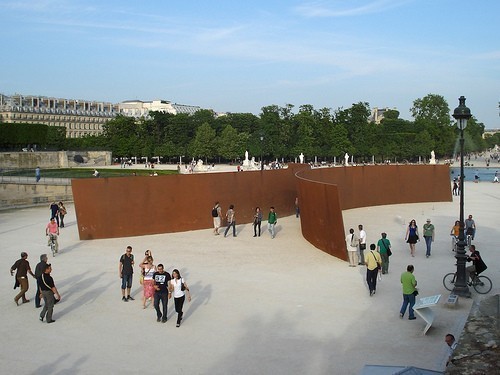 Clara-Clara by Richard Serra
Clara-Clara by Richard SerraOf course he is not speaking for American ideology, that would be too literal, but all the same, there are those wide-open spaces. I think he is simply taking possession of a space. For example, while “land art” exists in Europe, there is very little of it compared with the US!
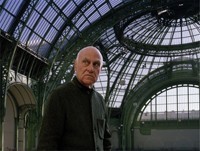 Richard Serra
Richard SerraIt also expresses a certain American feeling, a feeling of strength: dominating nature and organizing it. I am here in this world, and that's enough for him. The calm strength of those slabs also creates great serenity in the space of the Grand Palais. But it is also the strength of the steel industry, a technical strength. Obviously, it is the type of work that requires considerable resources and the support of big companies! It could not be done alone, with two or three assistants.
It shows a whole system of art, and at the same time, when the artist was making these works, he was saying to himself: “No one will be able to buy this, we're against the market”. But photographs of land art were sold to magazine, there was no escaping the market.
“It's unquestionably a work of art.”
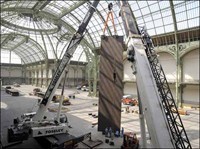 'Promenade', installation, (c) Richard Serra
'Promenade', installation, (c) Richard SerraThe idea that sculpture involves weight and balance and always has, Serra is working in the tradition of the Greeks, but with raised pieces that have no content, no aim. Yet there is always the question of space, time, light, the seasons, so it serves as a sacred calendar.
You see, when you go to the Grand Palais and look at those slabs, they are something that cannot be instantly consumed. You have to be there, you have to walk around them, and look, and walk back behind two or three slabs, and then come back. It is not a work for immediate consumption.
Whether or not one agrees with Serra, we have to give him his due. There is genuine work involved, the work of a surveyor, creating a perspective, and achieving monumental proportions. It must be said that when you are next to it and you feel this enormous mass beside you, it has a physical effect... of weight and volume. As always, in the tradition of sculpture, it is the WEIGHT.
And by the way, in contemporary art, one no longer says it is a question of beauty, but rather, ‘It's interesting'.”
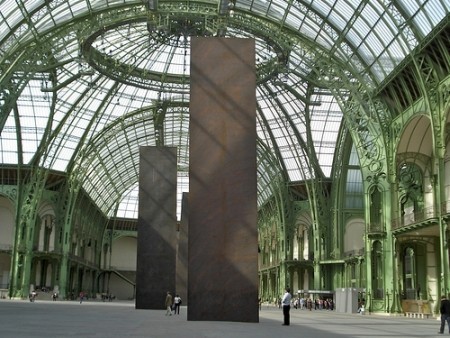 'Promenade' by Richard Serra
'Promenade' by Richard SerraWe'll let Richard Serra have the last word:
“...visitors are the ones who creates the work by walking around it, adopting different perspectives, redefining it and taming by looking at it with that other factor which is time.” “Art is not an object for immediate consumption... I want to create a different way of looking at the space and the architecture of the Grand Palais, as well as this city, with its glorious beauty intact.”
Par



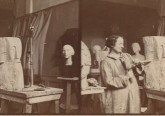


Ajouter un commentaire